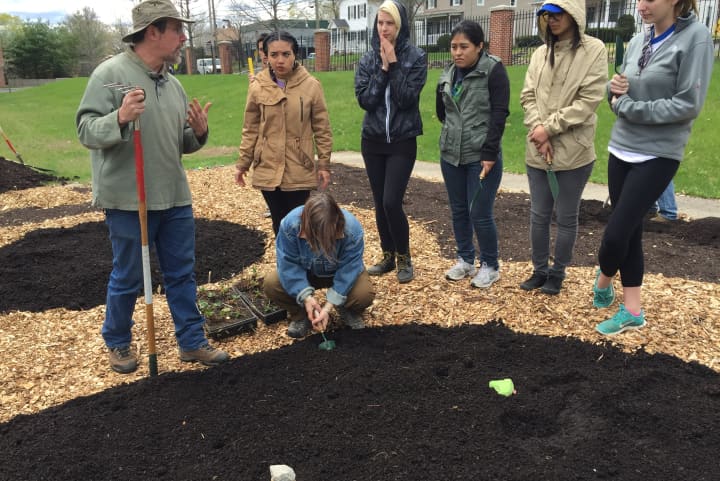The school’s Garden Design Team began planting the permaculture garden Monday afternoon. Students, staff and volunteers began by moving compost into planting beds and laying the first plants of the garden.
“It’s a garden with plants that are all interconnected. We’re not planting invasives or things that require a lot of care, we’re planting things that will work with each other,” said Laurie Weinstein, chair of the Jane Goodall Center at WCSU.
Weinstein is leading the project along with Ryan Harb, a consultant who works with schools, businesses and other organizations to help them grow more local and sustainable foods. Harb created a permaculture garden at UMass-Amherst and was named a White House Champion For Change after the success of that project. WCSU is also working with consultants Jono Nieger of Regenerative Design Group and Bill Bean of Green Planning and Coaching on the project.
The garden is divided into zones for different plantings. One will have the Native American companion plants of corn, beans and squash. Another section will be a berry patch with raspberries, strawberries, Asian pears, and Goji berries. There will also be a section for a mix of annual vegetables, herbs and flowers that Neiger said will bring in beneficial insects.
“There will be room for classes in the science building to plant student projects, so there will be lots of opportunities to weave in educational components,” Neiger said.
Harb said that one of the most important aspects of the project is the fact that it brings people together to create the garden. Students and faculty can maintain it, and members of the community are invited to participate in the project as well.
“It shows what people who work together are capable of: empowering things to come to life and thrive,” Harb said. “It’s not just sticking plants in the ground, it’s a whole culture of doing something together, creating something that’s beneficial and nutritional.”
Before the planting began an Native American ceremony was performed by Drew Shuptar-Rayvis, a junior anthropology student at WCSU who is of Accomac/Pocomoke descent. He blessed the ground and performed a smudging ritual designed to cleanse everyone who worked on the garden. He said he was excited about the planting of the “three sisters” of corn, beans and squash, which were traditional Native American plantings before the area was settled.
“It’s a great thing to put upon the land once more. It connects Danbury with the past and the present.”
Click here to follow Daily Voice Danbury and receive free news updates.





